Settlers are the most important units in the game, quickly followed by workers. Without your first settler you would not have a capital and thus your ‘civilization’ would quickly become a lost civilization. A myth to some as nothing but perhaps some backpacks would be left to let anyone know that your nomadic people ever existed. When you settle your first city, you begin on the journey to greatness (or failure) and begin to etch your name into the world history books. Knowing where to send your nomadic people and manage their new settlements will determine how much your civilization will succeed.
4000 BC
Here is our start. We see a nice cattle. We send our worker there FIRST before building our capital for two reasons. #1. Our worker is going to that tile anyways, because that is the best tile available. #2. Our worker might reveal a better location for our capital. The description of this game is Deity level, Pangaea map, standard size map with 5 AI opponents, sedentary barbs. So we have no threat of barbs except from goody huts, so we can take more risks in how we defend our settlers/cities from barbs. But on deity level, huts are not very nice to you as they are on lower levels, so we must pop huts with care (make sure we have other units nearby to help defend a city if nasty barbs do spew from a hut). Knowing the map size and # of opponents is important so we can give more of an educated guess as to how much room we will have to expand. We still need some warriors out exploring to find out exactly how much room we have, though.
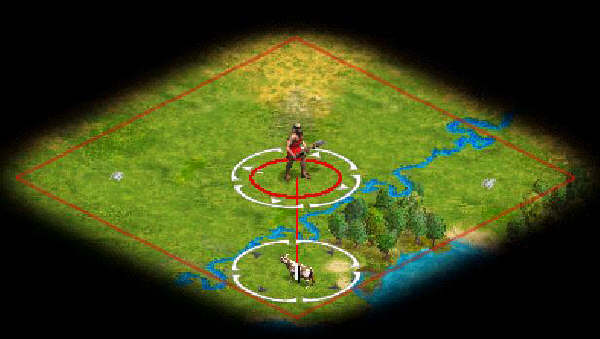
4000 BC2
By moving the worker first, we did in fact see a better location for our capital. If we move our settler just 1 tile, we can be on the coast (for building ships, and possible wonders on lower difficulty levels), still be on the valuable river and still have the cattle and also get the whale within our culture borders. Our worker will irrigate the cattle as his first priority to speed up growth. Since we do not have pottery to build a granary, we will research it at 100% science (or as high as possible) and get it in 20 turns. The time may change as we grow in size, build roads, and have to adjust our luxury tax, but we will get it pretty quick. After building our capital, we will find we will also have a wheat in our borders. This information will be very important in the moves ahead, and you’ll see why…

3650 BC
Our capital has just gained a citizen. There are a few things to notice about our city now. First, on this level (deity and also on emperor) we only get 1 content person! When you micromanage instead of using the governor, you have a 1 turn ‘grace period’ before your city goes into disorder, so we must take care of the unhappiness before ending our turn to avoid our people rioting. Second, notice that I have 4 shields added towards the warrior. We get the shields from the new citizen, the same turn he was added to our city. A person using the governor would have that second person automatically turned into an entertainer losing out on 2 shields if he hadn’t ‘predicted’ the future happiness needs and taken care of it the turn BEFORE. Third, we need 6 shields to get the next warrior. We will get this in 2 turns whether we work on the forest or work on the bonus grassland. We will move our citizen to work the bonus grassland instead to benefit from the extra food and also pick up an extra gold piece.
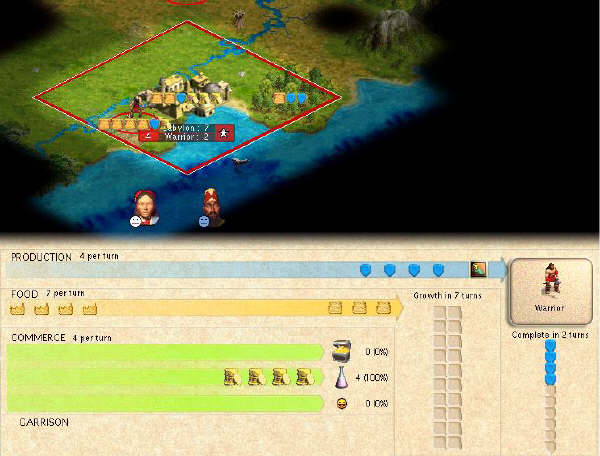
3150 BC
By selecting a barracks (or Colossus) to build (pre-build), but then switching to granary once we got pottery, we will complete the granary just before the city grows in size. You want the granary completed before growing in size, so that 10 food units we already had stored will instantly go into the granary, giving us the benefit of the granary right away and only need 10 food to get to the next population level. If we completed the granary at the same time, or just after growing in size, our granary will be empty and will have to get 20 food again to get to the next population size. Also notice we had been using our luxury tax to keep our people happy, so we can send all our warriors out to explore to give us valuable information on where we should build our future cities, to meet our neighbors, and maybe get some goodies from huts (but in this game I just got maps and barbs-my warriors survived).
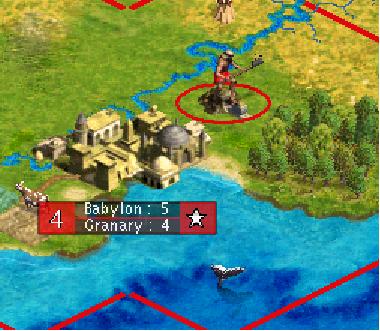
2750 BC: First Settler
We have produced the first of many settlers. We will now produce a settler every 4 turns from just the capital alone. With the irrigated cattle and the irrigated wheat we will now gain 2 population points every 4 turns which will keep pace with the 2 population we lose when we build a settler every 4 turns. Now we just need 30 shields every 4 turns… DO NOT WORK THE FOREST. Working the forest slows our growth and we will only produce a settler every 6 turns on average since we will grow 2 pop every 6 turns. DO NOT GET TO SIZE 7. When you get to size 7 the granary is emptied, negating the whole purpose of making our settler factory. Right now it says we will produce 6 shields, but the turn the citizen is added, the citizen will be placed on the forest netting us some extra shields. We just need to take the citizen off the forest and place him on a more preferable tile each time our city grows. Turn 1, 8 shields. Turn 2, 7 shields. Turn 3, 9 shields, Turn 4, 7 shields for 31 shields every 4 turns.
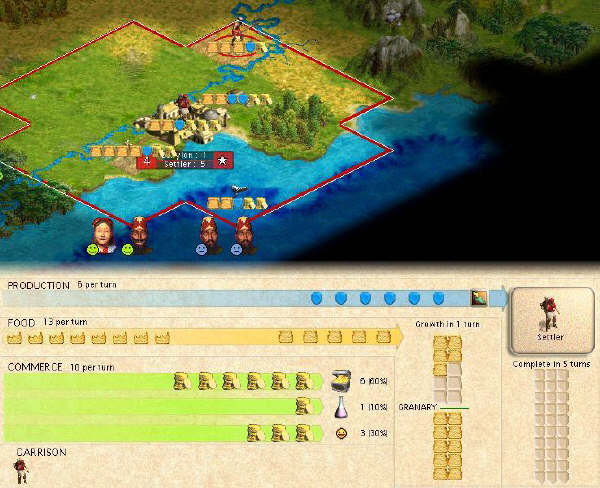
+5 Food
Having a city produce 5 extra food every turn with a granary is the most optimal situation you can have for a settler factory. With a granary you need 10 food for each population point, so 5 is easily divided by this. If we had more bonus resources around it would not do us any good to produce 6 or 7+ extra food per turn as we would still need 2 turns to grow (food does not carry over) until we get to size 7+. Had we mined the cattle we would grow a pop point every 3 turns instead of 2 since we would be only gaining 4 extra food/turn. If we also mined the wheat we would take 4 turns. Without having a granary we would take 4 turns to grow at +5 food, 5 turns at +4 food, and 7 turns at +3 food. So at best our settler factory without a granary would produce a settler every 8 turns at +5 food, 10 turns at +4 food, and 14 turns at +3 food. If the wheat had been on grassland instead of plains we would have had to mine either the wheat or cattle unless we want to work the forest.

Floodplain City!
Our exploring warriors have uncovered some very useful information about our surroundings. We do have 2 different luxuries nearby. There is also floodplains to the north with wheat! The dyes we will claim uncontested as there is no threat of any other civ claiming it in the near future. The gems also looks like we can claim easily. We do not know too much about what is to the east, though. We will take a gamble and pursue the floodplains before the luxuries. We have seen green borders to the north (we know the green borders belong to Persia because we have met the Persian spearman you see to the left), so we will race to this area and hopefully beat them to this great site. This will hurt our economy temporarily but we are still running a profit even with the high luxury tax, and we do not need money for research since we are researching at 10%. Claiming real estate and valuable food areas are more important at the moment. Remember, we have more settlers coming out every four turns.
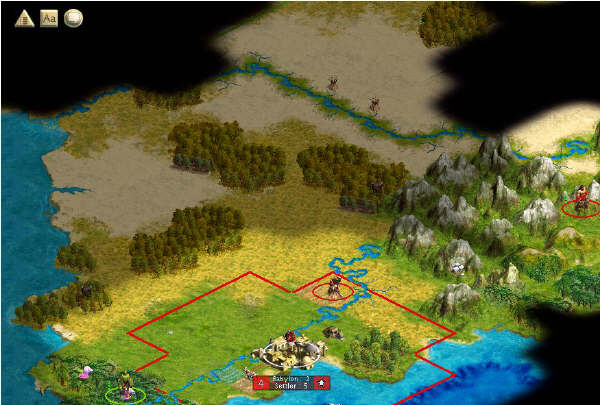
Just beat the Persians!
Our gamble pays off. It appears that the Persians liked the looks of those floodplains also. Fortunately we beat them to it just barely. We did take our time (moving 1 tile at a time), so had the Persians beat us, we could have settled a little further south and still claimed the game at least. Other than this floodplain city, there wasn’t very many bonus resources around, so other than for the sole purpose of getting luxuries this was probably the best location we could claim. Our warriors see alot of green borders to the north, so they will head east, mainly along the mountaintops (better vision) to see what awaits us there. They will eventually uncover some incense (and later iron when we get iron working). We will build some cities along the floodplain/mountain areas to claim the incense (and later iron once we found out where it was) and fill in the southern coast later. Our new cities will build warriors and workers and a couple may also build a settler.
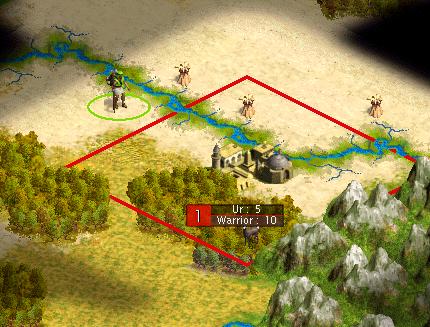
Trade with Persia
Xerxes is annoyed with us. We have found out that we are alone on this continent with Persia. After getting our luxuries hooked up and warriors in our cities as military police we were able to lower our luxury tax and make alot more money. We can’t yet afford Iron Working, but we will buy some other cheap techs from Xerses and pay this over time (gold/turn payments). The second tech we buy will be iron working to reveal where the iron is, if there is any. By entering a gpt agreement, Persia has less of an incentive to attack us, because then his payments would be cut off. We are pretending to be ‘the good neighbor’ for now. Persia did demand tribute once (23 gold and territory map) which we happily paid since we were in no position to defend ourselves at that time. As we grew in size (territory and military size), never again would he demand anything from us. He immediately went to ‘cautious’ after we made our first trade.

1200 BC
 Having our capital spit out settlers every 4 turns allows us to keep pace with Persia in the land grab phase of the game, despite the fact that they started with a free settler and have a 40% advantage over us in growth and production. We will now hunker down and start building up our empire. Our goal now is to rid the evil Persians of our continent, so our cities will produce workers, barracks and military units after building a temple for some cheap culture.
Having our capital spit out settlers every 4 turns allows us to keep pace with Persia in the land grab phase of the game, despite the fact that they started with a free settler and have a 40% advantage over us in growth and production. We will now hunker down and start building up our empire. Our goal now is to rid the evil Persians of our continent, so our cities will produce workers, barracks and military units after building a temple for some cheap culture.
War Preparations
Here is our attack plan. We will strike Gordium, then Susa, then finally Persepolis. Notice our attack route does not have us attacking from across a river when we attack the cities themselves. Rivers give defenders an advantage. Although this will give Persia an advantage on the counterattack, but hopefully we will be doing most of the attacking. We are building lots of warriors that we will upgrade to swordsmen when we get our iron hooked up. We will send a stack of 10-15 swordsmen in the initial assault with re-inforcements continually pouring in from our productive cities, and other warriors scattered around our cities that can be upgraded when needed. All of our cities have temples (some of these were whipped at the cost of 1 citizen), and most have barracks (some of these whipped at the cost of 2 citizens). Having 3 luxuries hooked up allowed us to be more flexible in how much we use the whip. We make our first strike at 670 BC.

Protecting the Iron City
The city that holds our iron resource must be protected at all costs. We have fortified swordsmen on the mountains around this valuable city. A swordsman (defense 2) basically has a defense value of 4 (4.5 when fortified) when he is on a mountain. Persia does not have iron themselves yet, so their attack values of 2 (horseman and archers) are no match for the 4 defense of a swordsman on a mountain. Also, with our 3 attack of our swordsmen we can also drop down from the mountains and attack when we so desire. Just remember that the swordsmen will then lose his foothold on the mountain due to his 1 movement point, and you don’t want the enemy to gain control of a mountain tile. It’s best to have several swordsmen so some can come off the mountain when needed, while others keep control of the position (the mountain tile). Persia would sometimes send a spearman to try and pillage my iron, so you must watch for that and get the spearman before he can get onto a mountain tile.

Contact with Zulu
In one of our peace treaties with the Persians we notice that they have a city that we do not see anywhere on the map. This city is obviously on an island or a foothold on another continent. We did not have any maps yet, or contact with any other civ. We can ask for the city OR ask for techs/gold, not both. We decide to take the city, so that we wouldn’t have to go hunting down the Persians on little islands later in the game (very annoying). We find the city is on an island shared with another civ, but can’t establish contact until we get a unit there, or the other civ has a unit peek it’s head outside the city to see us. The second time the Zulu swordsman sticks his head outside of town he is on his way to capture our city. We should have built a warrior before the worker…..the AI loves attacking undefended cities. Now that we have contact with another civ we will buy techs like Writing before signing peace treaties, so that other options like literature are available to us in the peace treaty.
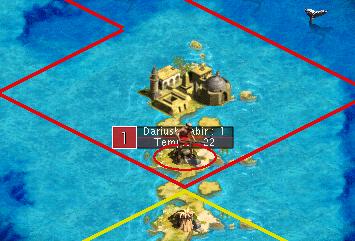
Persia’s Last Hope
After continuous wars with Persia we have succeeded in capturing Persepolis and the Pyramids (we also got a leader and rushed the Forbidden Palace). We took a look around the map and notice there is an unclaimed iron resource. We send a settler there to claim it. To get there faster we sign a Right of Passage with Persia so our settler won’t get hassled going through Persia territory. But as the settler approaches we see that Persia has already set up a colony and claimed ‘our’ iron. We declare war over this iron to deny Persia keeping the iron and build up immortals. Unfortunately, this will also ruin our reputation because we broke the Right of Passage treaty, and also the Peace treaty.

230 AD
 Persian territory is progressively consolidating into ours through the successful wars. Soon this continent will be solely a Babylonian one.
Persian territory is progressively consolidating into ours through the successful wars. Soon this continent will be solely a Babylonian one.
Research
On deity level the human is penalized so much that it is not worth it to try and beat the AI in the tech race early in the game. So we will buy our techs, but spend a minimal amount and hope we can beat the AI to a tech and reap the benefits from it in trades. Even though it took us 40 turns to get Alphabet, Persia beat us to it by only 4 turns. We then studied Mathematics, but with a lone scientist. Even during a golden age, this city is not producing more than the minimum shields/gold. So we allocate one of these citizens as a scientists, so that 10% more gold from all of our other cities can go towards other things and we will still learn techs every 40 turns. Unfortunately, I got careless and did not notice when the scientist would quit and become a worker (or die of disease when the scientist was in a floodplain city), so we lost our chance at getting mathematics first. Had I been more careful we would have beaten both Persia and Zulu to Mathematics because both of them chased after Republic first.

460 AD: New Civs Gracious
Our dockworkers have spotted some foreign ships off of our coast. We make contact with them and learn there are new civilizations out there. They call themselves the Chinese, Japanese, and Indians. We trade with them extensively. We buy all of their contacts first, then shop around to see who has what techs. Since India is behind the others (but ahead of us), we can buy some techs India is missing, then trade techs with India (and Zulu) for the other techs we are missing. The Zulu were farther along the bottom of the tech tree and had gunpowder, which we were able to trade to the rest of the world. We trade techs, luxuries, and maps with the new world, and then finally sell our contact with the Zulu and get some money back. We did not sell contact with the Zulu first because he would have told everyone of our misdeeds against the Persians making our luxuries worthless as no one would trade with us. Also signed ROP before letting our bad rep be known to all. We now have tech parity with everyone.
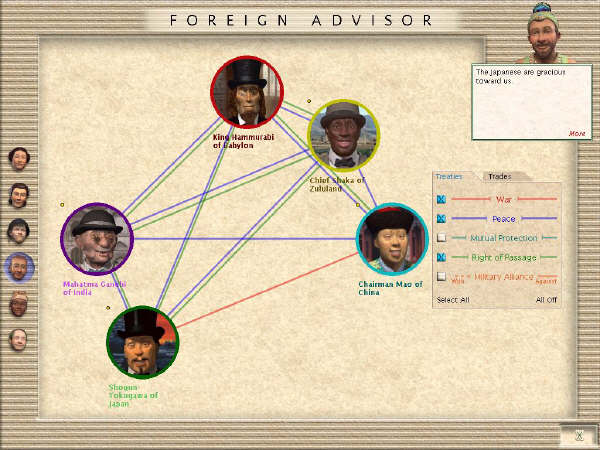
Magnetism
Since there are few tech options to research at the moment we still have science at 0% and will just buy techs from the AI after 3 or 4 civs have the tech. Though the price may seem high, it is only the same amount of money we can make in 1 and a half turns. Having the forbidden palace, being a democracy and having marketplaces and banks in nearly every city allowed us to make this great income. We will continue building improvements in our cities for now to make our empire even more productive, still leaving just swordsmen in many of our cities as a minimal defense. We are buying our techs mainly from Gandhi as he is offering the best prices. He is Gracious with us for supplying him with saltpeter, that he has been giving us better offers on the prices for techs he offers us.

Nationalism Slingshot
By buying the last required tech in the middle ages, we get our free tech which is nationalism. Since we are the only scientific civ left in the game, we have a monopoly on this tech, so we sell it to bankrupt the other civs. We end up getting 449 gold per turn for the next 20 turns and an additional 2909 gold. So we will get 11,889 gold after 20 turns. Not bad for a 975 gold investment…..Now we set science to 100% towards steam power while the AI pursues communism. We will not sell steam power because we want the shields the AI had built towards Newton’s not be able to transfer to Universal Suffrage. By making them go Steam Power–>Industrialization all by themselves, the wonder cascade ends with Newton’s, so we get Universal Suffrage, TOE, and Hoover’s with no competition. We are learning techs every 5-6 turns and will hold a tech lead and once we get TOE, we will have a 2-3 tech lead that we will never lose.
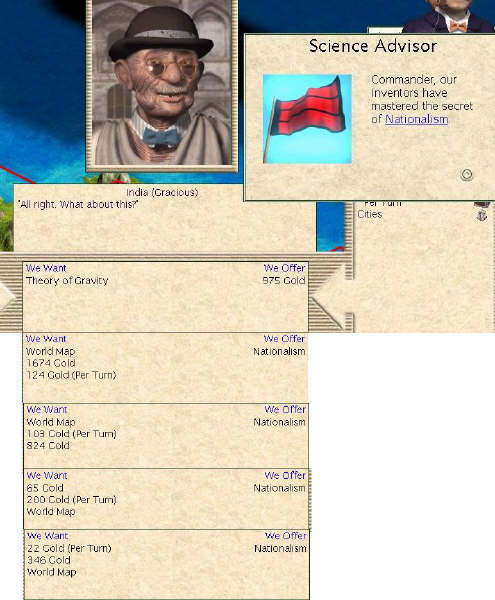
Foothold on Other Continent
Japan and India have been at war with the Chinese for a long time. The Chinese finally fall apart and the Japanese and Indians start conquering their lands. Though we did not actually engage in any gunfire with the Chinese, we did join the war against them and will now try to salvage some of their lands and claim it as our own.. We build a single transport and fill it with infantry and 1 settler. The transport will be escorted by a single battleship. We nestle a city in between other cities that have recently been captured by Japan from China. We claim 3 resources (iron, coal, saltpeter) with this city. We first rush some culture (a library), then an airport, then proceed to build more culture to prevent a flip. We will now airlift many freshly built tanks to this new city. We will have about 50 tanks in this city (some parked outside in case of a flip) when Japan demands tribute from us (dyes). We call his bluff and he declares war. Our 50 tanks quickly capture many Japanese cities.
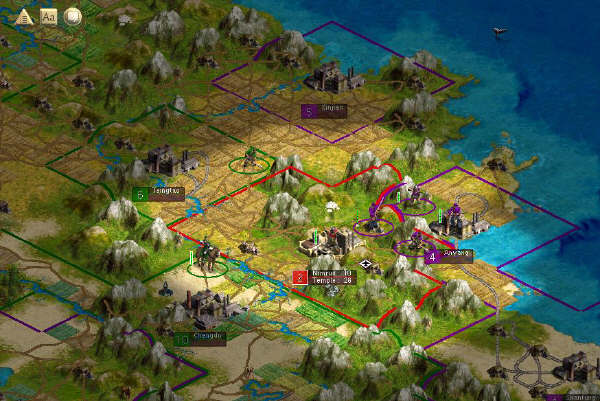
Finally a Decisive UN Vote
We had held elections before (first vote was in 1360 A.D.) and Japan voted for us (before the Babylon-Japan war). India voted for Shaka because of our bad rep and he had a MPP with the Zulu. So the prior vote was inconclusive, but we found out who our likely competitor would be in future elections. After Japan gets down to 1 city (size 2) the foolish Gandhi feels he needs a nuke to take out that small Japanese city. Because of the ruthless use of a weapon of mass destruction, Shaka declares war on Gandhi. We had a MPP with Gandhi, so must declare war on Shaka. We seize the opportunity to hold an election and of course Gandhi votes for us (the AI will never vote for someone they are at war with).

Babylon’s Final Empire
We claimed all of Japan’s lands, and much of former China’s lands. We won diplomatically (India voted for us). We could have launched our spaceship centuries ago. We are about 300 tiles from domination. India hasn’t even started their spaceship. The Zulu had started theirs, built 7 spaceship parts and by luck, their spaceship parts were saved (I failed to capture and raze their capital), but they must re-build the Apollo Program since the city that had it was razed, and they lack uranium and many other important resources. Their capital has already been nuked, and all their major cities can easily be nuked in the next few turns, so conquering them would be no problem. We spent the last 30 turns or so in Monarchy so we could enjoy some modern warfare and so that is why the Zulu had time to build some spaceship parts. We finally end this ‘Zulu in Space’ nonsense in the early 1700’s.

